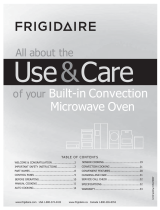
9 IMPORTANT SAFETY INSTRUCTIONS
READ ALL INSTRUCTIONS BEFORE USING THE APPLIANCE
4
IMPORTANT SAFETY INS READ ALL INSTRUCTIONS BEFORE USING THE APPLIANCE
9 PRECAUTIONS TO AVOID
POSSIBLE EXPOSURE TO
EXCESSIVE MICROWAVE
ENERGY
PRECAUTIONS TO AVOID POSSIBLE EXPOSURE TO
EXCESSIVE MICROWAVE ENERGY
(1) Do not attempt to operate this oven with the door
open, since open-door operation can result in harmful
exposure to microwave evergy. It is important not to
defeat or tamper with the safety interlocks.
(2) Do not place any object between the oven front face
and the door or allow soil or cleaner residue to
accumulate on sealing surfaces.
(3) Do not operate the oven if it is damaged. It is
particularly important that the oven door close properly
and that there is no damage to the:
▯ door (bent)
▯ hinges and latches (broken or loosened)
▯ door seals and sealing surfaces.
(4) The oven should not be adjusted or repaired by
anyone except properly qualified service personnel.
Improper installation, service or maintenance can cause
injury or property damage. Refer to this manual for
guidance. Refer all servicing to a factory authorized
service center.
WARNING
To reduce the risk of burns, electric shock, fire, injury to
persons, or exposure to excessive microwave energy,
read all instructions before using the appliance.
WARNING
If the information in this manual is not followed exactly,
fire or shock may result causing property damage or
personal injury.
When using electrical appliances basic safety
precautions should be followed, including the
following:
Read and follow the specific “PRECAUTIONS TO AVOID
POSSIBLE EXPOSURE TO EXCESSIVE MICROWAVE
ENERGY” found in the Safety Instructions chapter.
This appliance must be grounded. Connect only to
properly grounded outlet (see GROUNDING
INSTRUCTIONS).
Install or locate this appliance only in accordance with
the provided installation instructions.
Some products such as whole eggs and sealed
containers – for example, closed glass jars – are able to
explode and should not be heated in this oven.
Use this appliance only for its intended use as described
in the manual. Do not use corrosive chemicals or vapors
in this appliance. This type of oven is specifically
designed to heat, cook, or dry food. It is not designed for
industrial or laboratory use.
As with any appliance, close supervision is necessary
when used by children (see CHILD SAFETY).
This appliance should be serviced only by qualified
service personnel. Contact nearest authorized service
facility for examination, repair, or adjustment.
Do not cover or block any vents or openings on the
appliance.
Do not store this appliance outdoors. Do not use this
product near water – for example, near a kitchen sink, in
a wet basement, near a swimming pool, or similar
locations.
Suitable for plug-connected only:
(1) Do not immerse cord or plug in water.
(2) Keep cord away from heated surfaces.
(3) Do not let cord hang over edge of table or counter.
(4) Do not operate this appliance if it has a damaged
cord or plug, if it is not working properly, or if it has
been damaged or dropped.
When cleaning surfaces of door and oven that come
together on closing the door, use only mild, nonabrasive
soaps, or detergents applied with a sponge or soft cloth.
See door surface cleaning instructions in chapter
“Cleaning and Maintenance”.
To reduce the risk of fire in the oven cavity:
▯ Do not overcook food. Carefully attend appliance
when paper, plastic, or other combustible materials
are placed inside the oven to facilitate cooking.
▯ Remove wire twist-ties from paper or plastic bags
before placing bag in oven.
▯ If materials inside the oven ignite, keep oven door
closed, turn oven off, and disconnect the power cord,
or shut off power at the fuse or circuit breaker panel.
▯ Do not use the cavity for storage purposes. Do not
leave paper products, cooking utensils, or food in the
cavity when not in use.
GROUNDING INSTRUCTIONS
This appliance must be grounded. Grounding reduces
risk of electric shock by providing a safe pathway for
electric current in the event of a short circuit.
If this oven is equipped with a cord having a grounding
wire with a grounding plug. The plug must be plugged
into an outlet that is properly installed and grounded. See
INSTALLATION INSTRUCTIONS.
Consult a qualified electrician or servicer if grounding
instructions are not completely understood, or if doubt
exists as to whether the oven is properly grounded.
Do not use an extension cord. If the product power cord
is too short, have a qualified electrician install a three–
slot receptacle. This oven should be plugged into a
separate 60 Hertz circuit with the electrical rating as
shown in specifications table. When the oven is on a




















